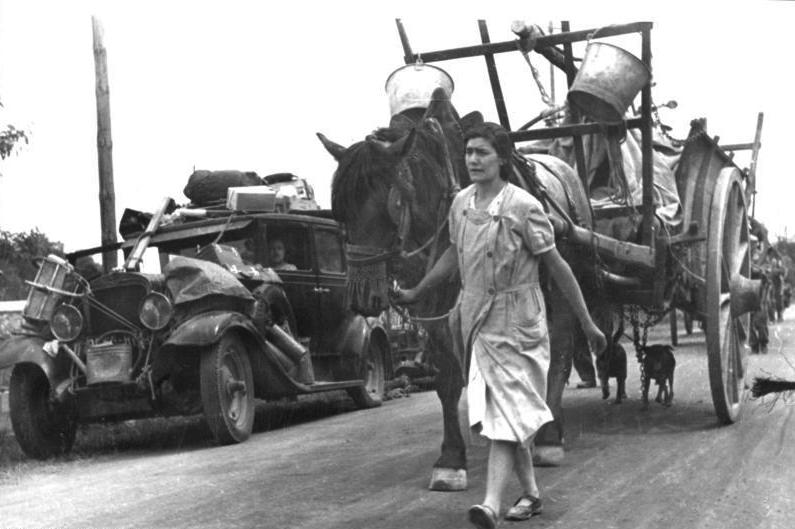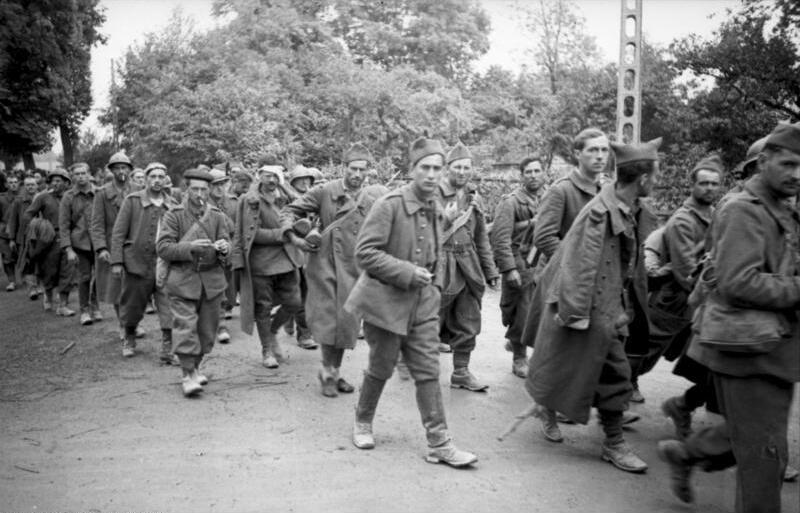|
Chasselay Massacre
The Chasselay massacre was the mass killing of French prisoners of war by German Army and ''Waffen-SS'' soldiers during the Battle of France in World War II. After capturing non-white French POWs during the capture of Lyon on 19 June 1940, German troops took approximately 50 Black soldiers to a field near Chasselay, and used two tanks to murder them. After the massacre, local civilians buried the dead in a mass grave despite German warnings not to do so. Vichy official Jean-Baptiste Marchiani ordered the construction of a cemetery for the victims, which opened in 1942. Background On 10 May 1940, Nazi Germany launched an invasion of France, eight months after the French declared war on the Germans following the German invasion of Poland that sparked World War II. German forces rapidly advanced into French territory as part of the Manstein Plan, before initiating the ''Fall Rot'' plan on 5 June. The French Armed Forces, which had deployed large numbers of colonial troops (i ... [...More Info...] [...Related Items...] OR: [Wikipedia] [Google] [Baidu] |
Battle Of France
The Battle of France (french: bataille de France) (10 May – 25 June 1940), also known as the Western Campaign ('), the French Campaign (german: Frankreichfeldzug, ) and the Fall of France, was the Nazi Germany, German invasion of French Third Republic, France during the Second World War. On 3 September 1939, France French declaration of war on Germany (1939), declared war on Germany following the German invasion of Poland. In early September 1939, France began the limited Saar Offensive and by mid-October had withdrawn to their start lines. German armies German invasion of Belgium (1940), invaded Belgium, German invasion of Luxembourg, Luxembourg and German invasion of the Netherlands, the Netherlands on 10 May 1940. Fascist Italy (1922-1943), Italy entered the war on 10 June 1940 and attempted an Italian invasion of France, invasion of France. France and the Low Countries were conquered, ending land operations on the Western Front (World War II), Western Front until the Normandy l ... [...More Info...] [...Related Items...] OR: [Wikipedia] [Google] [Baidu] |
Fall Rot
''Fall Rot'' (Case Red) was the plan for a German military operation after the success of (Case Yellow), the Battle of France, an invasion of the Benelux countries and northern France. The Allied armies had been defeated and pushed back in the north to the Channel coast, which culminated in the Dunkirk evacuation. The operation to complete the conquest of France by the German Army began on 5 June 1940. began with a preliminary attack over the river Somme on the Channel Coast to the Seine, beginning on 5 June and the main offensive by Army Group A on 9 June further east over the river Aisne. Background French defensive preparations By the end of May 1940, the best-equipped French armies had been sent north and lost in and the evacuation from Dunkirk, which cost the Allies French commander Maxime Weygand was faced with the prospect of defending a front from Sedan, along the Aisne and Somme rivers to Abbeville on the Channel, with divisions. The 51st (Highland) Infant ... [...More Info...] [...Related Items...] OR: [Wikipedia] [Google] [Baidu] |
Panzergrenadier Division Großdeutschland
The Panzergrenadier Division "Großdeutschland", also commonly referred to simply as Großdeutschland or Großdeutschland Division, was an elite combat unit of the German Army (''Heer'') that fought on the Eastern Front in World War II. Originally formed in 1921 it was known as the ''Wachregiment Berlin'' and served as a ceremonial guard unit and by the 1939 had grown into a regiment of the combined Wehrmacht German armed forces. The regiment would later be expanded and renamed Infantry Division Großdeutschland in 1942, and after significant reorganization was renamed Panzergrenadier Division Großdeutschland in May 1943. In November 1944, while the division retained its status as a panzergrenadier division, some of its subordinate units were expanded to divisional status, and the whole group of divisions were reorganized as Panzerkorps Großdeutschland. 1939–1942 The Infantry Regiment Grossdeutschland was activated on 14 June 1939. The regiment saw action in France in 1940 ... [...More Info...] [...Related Items...] OR: [Wikipedia] [Google] [Baidu] |
Philippe Pétain
Henri Philippe Benoni Omer Pétain (24 April 1856 – 23 July 1951), commonly known as Philippe Pétain (, ) or Marshal Pétain (french: Maréchal Pétain), was a French general who attained the position of Marshal of France at the end of World War I, during which he became known as The Lion of Verdun (french: le lion de Verdun). From 1940 to 1944, during World War II, he served as head of the collaborationist regime of Vichy France. Pétain, who was 84 years old in 1940, remains the oldest person to become the head of state of France. During World War I, Pétain led the French Army to victory at the nine-month-long Battle of Verdun. After the failed Nivelle Offensive and subsequent mutinies he was appointed Commander-in-Chief and succeeded in repairing the army's confidence. Pétain remained in command for the rest of the war and emerged as a national hero. During the interwar period he was head of the peacetime French Army, commanded joint Franco-Spanish operations during ... [...More Info...] [...Related Items...] OR: [Wikipedia] [Google] [Baidu] |
Bundesarchiv Bild 183-L05109, Kriegsgefangene Französische Kolonialsoldaten
, type = Archive , seal = , seal_size = , seal_caption = , seal_alt = , logo = Bundesarchiv-Logo.svg , logo_size = , logo_caption = , logo_alt = , image = Bundesarchiv Koblenz.jpg , image_caption = The Federal Archives in Koblenz , image_alt = , formed = , preceding1 = , preceding2 = , dissolved = , superseding1 = , superseding2 = , agency_type = , jurisdiction = , status = Active , headquarters = PotsdamerStraße156075Koblenz , coordinates = , motto = , employees = , budget = million () , chief1_name = Michael Hollmann , chief1_position = President of the Federal Archives , chief2_name = Dr. Andrea Hänger , chief2_position ... [...More Info...] [...Related Items...] OR: [Wikipedia] [Google] [Baidu] |
Wehrmacht
The ''Wehrmacht'' (, ) were the unified armed forces of Nazi Germany from 1935 to 1945. It consisted of the ''Heer'' (army), the ''Kriegsmarine'' (navy) and the ''Luftwaffe'' (air force). The designation "''Wehrmacht''" replaced the previously used term and was the manifestation of the Nazi regime's efforts to rearm Germany to a greater extent than the Treaty of Versailles permitted. After the Nazi rise to power in 1933, one of Adolf Hitler's most overt and audacious moves was to establish the ''Wehrmacht'', a modern offensively-capable armed force, fulfilling the Nazi régime's long-term goals of regaining lost territory as well as gaining new territory and dominating its neighbours. This required the reinstatement of conscription and massive investment and defense spending on the arms industry. The ''Wehrmacht'' formed the heart of Germany's politico-military power. In the early part of the Second World War, the ''Wehrmacht'' employed combined arms tactics (close- ... [...More Info...] [...Related Items...] OR: [Wikipedia] [Google] [Baidu] |
Black Horror On The Rhine
The Black Horror on the Rhine was a moral panic aroused in Weimar Germany and elsewhere concerning allegations of widespread crimes, especially sexual crimes, said to be committed by Senegalese Tirailleurs, Senegalese and other African soldiers serving in the French Army during the French occupation of the Rhineland between 1918 and 1930. ''Die schwarze Schande'' or w:de:Alliierte Rheinlandbesetzung#.E2.80.9ESchwarze Schmach.E2.80.9C, ''Die schwarze Schmach'' ("the Black Shame" or "the Black Disgrace") were terms used by right-wing press as German nationalism, German nationalist propaganda in opposition to these events. The colonial troops referred to were soldiers from Senegal, Indochina, and Madagascar. The majority of colonial African soldiers were accused of committing rape and mutilation against the German population. The campaign reached its peak between 1920 and 1923, but did not stop until 1930. Adolf Hitler blamed Jews for bringing the Senegalese into the Rhineland. Along ... [...More Info...] [...Related Items...] OR: [Wikipedia] [Google] [Baidu] |
French Colonial Empire
The French colonial empire () comprised the overseas colonies, protectorates and mandate territories that came under French rule from the 16th century onward. A distinction is generally made between the "First French Colonial Empire", that existed until 1814, by which time most of it had been lost or sold, and the "Second French Colonial Empire", which began with the conquest of Algiers in 1830. At its apex between the two world wars, the second French colonial empire was the second-largest colonial empire in the world behind the British Empire. France began to establish colonies in North America, the Caribbean and India in the 17th century but lost most of its possessions following its defeat in the Seven Years' War. The North American possessions were lost to Britain and Spain but the latter returned Louisiana (New France) to France in 1800. The territory was then sold to the United States in 1803. France rebuilt a new empire mostly after 1850, concentrating chiefly in Af ... [...More Info...] [...Related Items...] OR: [Wikipedia] [Google] [Baidu] |
French Prisoners Of War In World War II
During World War II, the French prisoners of war were primarily soldiers from France and its colonial empire captured by Nazi Germany. Although no precise estimates exist, the number of French soldiers captured during the Battle of France between May and June 1940 is generally recognised around 1.8 million, equivalent to around 10 percent of the total adult male population of France at the time. After a brief period of captivity in France, most of the prisoners were deported to Germany. In Germany, prisoners were incarcerated in ''Stalag'' or '' Oflag'' prison camps, according to rank, but the vast majority were soon transferred to work details ('' Kommandos'') working in German agriculture or industry. Colonial prisoners, however, remained in camps in France with poor living conditions as a result of Nazi racial ideologies. During negotiations for the Armistice of 22 June 1940, the Vichy French government adopted a policy of collaboration in hopes for German concessions ... [...More Info...] [...Related Items...] OR: [Wikipedia] [Google] [Baidu] |
Somme (department)
Somme (; pcd, Sonme) is a department of France, located in the north of the country and named after the Somme river. It is part of the Hauts-de-France region. It had a population of 570,559 in 2019.Populations légales 2019: 80 Somme INSEE The north central area of the Somme was the site of a series of battles during , including the particularly significant in 1916. As a result of this and other battles fought in the area, the department is home to many military [...More Info...] [...Related Items...] OR: [Wikipedia] [Google] [Baidu] |
Metropolitan France
Metropolitan France (french: France métropolitaine or ''la Métropole''), also known as European France (french: Territoire européen de la France) is the area of France which is geographically in Europe. This collective name for the European regions of France is used in everyday life in France but has no administrative meaning. Indeed, the overseas regions have exactly the same administrative status as the metropolitan regions. Metropolitan France comprises mainland France and Corsica, as well as nearby islands in the Atlantic Ocean, the English Channel (french: la Manche), and the Mediterranean Sea. In contrast, overseas France is the collective name for all the French territories outside Europe. Metropolitan and overseas France together form the French Republic. Metropolitan France accounts for 82.0% of the land territory, 3.3% of the exclusive economic zone (EEZ), and 95.9% of the population of the French Republic. Some small parts of France (e.g. Cerdanya) are a part ... [...More Info...] [...Related Items...] OR: [Wikipedia] [Google] [Baidu] |




.jpg)

